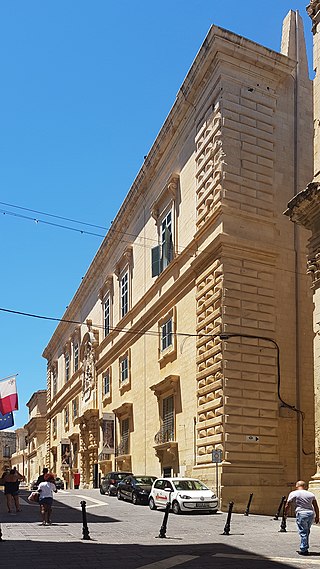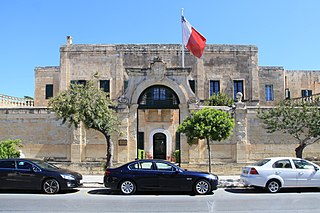
The Auberge d'Aragon is an auberge in Valletta, Malta. It was built in 1571 to house knights of the Order of Saint John from the langue of Aragon, Navarre and Catalonia. It is the only surviving auberge in Valletta which retains its original Mannerist design by the architect Girolamo Cassar.

The Royal Opera House, also known as the Royal Theatre, was an opera house and performing arts venue in Valletta, Malta. It was designed by the English architect Edward Middleton Barry and was erected in 1866. In 1873 its interior was extensively damaged by fire but was eventually restored by 1877. The theatre received a direct hit from aerial bombing in 1942 during World War II. Prior to its destruction, it was one of the most beautiful and iconic buildings in Valletta. After several abandoned plans to rebuild the theatre, the ruins were redesigned by the Italian architect Renzo Piano and in 2013 it once again started functioning as a performance venue, called Pjazza Teatru Rjal.

The Valletta Waterfront, is a promenade in Floriana, Malta, mainly featuring three prominent buildings: a church in the middle, the Pinto Stores or the Pinto Wharf on the left, and the Forni Stores or the Forni Shopping Complex on the right. The buildings were originally stores and warehouses, built in the 18th century, and the design is attributed to Andrea Belli.

The Palace Armoury is an arms collection housed at the Grandmaster's Palace in Valletta, Malta. It was the main armoury of the Order of St. John in the 17th and 18th centuries, and as such it was the last arsenal established by a crusader military order. Although today only a part of the original armoury still survives, it is still one of the world's largest collections of arms and armour still housed in its original building. The Palace Armoury has been open to the public as a museum since 1860.

Republic Square is a piazza in Valletta, Malta. The square was originally called Piazza Tesoreria or Piazza dei Cavallieri, since the treasury of the Order of Saint John was located in the square. After a statue of Queen Victoria was installed in the square in the 19th century, it became known as Queen's Square or Piazza Regina. Although its official name is Republic Square, it is still commonly referred to as Piazza Regina.

The Messina Palace, also known as Palazzo Messina, is a palace located at No 141 and 141A Strada San Cristoforo in Valletta, Malta. It was built by Fra Pietro La Rocca, Prior of Santo Stefano, towards the end of the 16th century and was once part of a grander palace called Casa Rocca Grande. The property has been occupied by the German-Maltese Circle since 1975, who purchased the building from the Stilon family in 1989.

The Auberge d'Auvergne was an auberge in Valletta, Malta. It was built in the 16th century to house knights of the Order of Saint John from the langue of Auvergne. It became a courthouse in the 19th century, and it remained so until it was destroyed by aerial bombardment in 1941. The site is now occupied by the Courts of Justice building, which was constructed in the 1960s.

The Auberge d'Italie is an auberge in Valletta, Malta. It was built at various stages in the late 16th century to house knights of the Order of Saint John from the langue of Italy, and it originally had a Mannerist design by Girolamo Cassar and several other architects. The building continued to be modified throughout the course of the 17th century, with the last major renovation being carried out in the 1680s during the magistracy of Gregorio Carafa, giving the building a Baroque character.

Palazzo Parisio, sometimes known as Casa Parisio, is a palace in Valletta, Malta. It was built in the 1740s by Domenico Sceberras, and eventually passed into the hands of the Muscati and Parisio Muscati families. It was Napoleon's residence for six days in June 1798, during the early days of the French occupation of Malta. The palace was eventually acquired by the de Piro family, and was later purchased by the Government of Malta. It was used as the General Post Office from 1886 to 1973, then the Ministry for Agriculture, and it now houses the Ministry for Foreign Affairs.

The Banca Giuratale, formerly also known as Banca dei Giurati, the Municipal Palace, the Palazzo della Città, Casa Città and the Consolato del Mare, is a public building in Valletta, Malta. It was built in the 18th century to house the city's administrative council, and it was subsequently used as the General Post Office and the Public Registry. The Banca Giuratale now houses the Ministry for the Economy,Enterprise and Strategic Projects, and it is officially known as Palazzo Zondadari.

Spinola Palace, also known as Spinola House, is a palace in Valletta, Malta. It belonged to the Spinola family between the 17th and 18th centuries. One third of the building was demolished in the 20th century, but the remaining two wings still exist and are now used as the head office of Lombard Bank.

Casa Leoni or Casa Leone, also known as Palazzo Manoel or the Vilhena Palace, is a palace in Santa Venera, Malta, which was built as a summer residence for Grand Master António Manoel de Vilhena in 1730. It was subsequently used for a number of purposes, including as an insurgent command base, an official residence, a museum depository and a school. It currently houses the Ministry for Transport, Infrastructure and Capital Projects (MTIP).

Bubaqra Tower, formerly named as Saliba Tower, is a fortified house in Bubaqra, limits of Żurrieq, Malta. It was built as a country retreat in the late 16th century. The tower and its gardens have been restored, and now serve as a family retreat. Officially named as Bubaqra Palace, it is a grade 2 national monument.

The Slaves' Prison officially known as the Grand Prison and colloquially as the bagnio, was a prison in Valletta, Malta. It was established in the late 16th century, and remained in use as a prison throughout the 17th and 18th centuries. It was subsequently used as a naval hospital, a school and an examination hall. It was bombed in World War II, and the ruins were demolished to make way for a block of flats.

Admiralty House, formerly known as Casa Miari, Palazzo Don Raimondo and by several other names, is a palace in Valletta, Malta. It was originally built in 1569–70 as two private houses by Fra Jean de Soubiran dit Arafat, a knight of the Order of St. John. The houses were later leased to various owners, including Fra Raimondo de Sousa y Silva, who rebuilt them a single residence between 1761 and 1763.

The Courts of Justice building is a courthouse located in Republic Street, Valletta, Malta. It was built in the neoclassical style between 1965 and 1971 on the site of Auberge d'Auvergne, which had been destroyed by aerial bombardment during World War II.

Republic Street, historically known as Strada Reale or Kingsway, is a principal street in the capital city of Valletta, Malta. It is about 1 kilometer long and is known for legislative, judiciary and commercial purposes. It is mostly pedestrianised.

The de Piro family is a Maltese noble family, of Italian origins, which settled in Malta with the Order of St John in 1530.

The remains of an unidentified Punic building exist incorporated into several properties in Żurrieq, Malta. They include a well-preserved structure commonly known as the Punic Tower or the Żurrieq Tower which is found inside the private garden of the Domus Curialis, the house of the town's archpriest, and which is the most substantial surviving example of Punic architecture on the island.






















